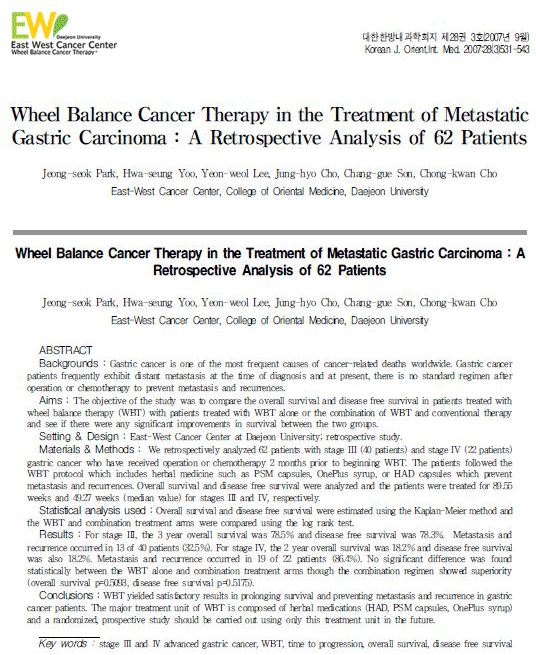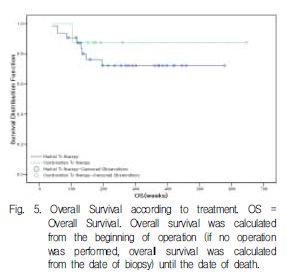수레바퀴 암 치료법을 시행받은 진행성 위암환자 62명에 대한 후향적 코호트 분석
등록2014-05-07 조회1,870본문

수레바퀴 암 치료법을 시행받은 진행성 위암환자 62명에 대한 후향적 코호트 분석. 대한한방내과학회지. 28(3):531-543, 2007
Wheel Balance Cancer Therapy in the Treatment of Metastatic Gastric Carcinoma : A Retrospective Analysis of 62 Patients. Korean J Orient Int Med. 2007;28(3):531-543.
<대상환자>
40 Stage III gastric cancer patients who had (or had not) undergone conventional therapy (surgical
procedures and chemotherapy), and 22 Ⅳ patients who had not undergone conventional therapy were treated at EWCC using the WBT regimen and analyzed retrospectively from May 2002 to March 2005.
(89.55weeks and 49.27 weeks)
<치료방법>
Wheel Balance Cancer Therapy
1)The treatment
A complete history and physical examination of the patient is completed by a physician within two weeks after treatment.(CBC, LFT, Raidology test)
2) Basic Treatment (Wheel Balance Program)
The basic treatment consists of 4 categories : diet, metabolism activation, anti-angiogenesis agents & Immunotherapy, controlled-breathing
and Meditation.
|
Group |
3기 |
4기 |
|
combination treatment of oriental and western medicine |
8명 |
0 |
|
treatment of oriental medicine alone |
32명 |
22명 |
<치료결과>

-> This study was carried out to prove the effects of WBT (Wheel Balance Therapy) for prolonging survival and preventing metastasis
and recurrence in gastric cancer patients.
|
3기 위암환자의 생존율 |
|||
|
|
1년 생존 |
2년 생존 |
3년 생존 |
|
WBT치료 추가군 |
97.5% |
89.9% |
78.5% |
|
항암제 치료군 (대조군) |
87.6% |
75.1% |
69.1% |
|
4기 위암환자의 생존율 |
||
|
|
1년 생존 |
2년 생존 |
|
WBT치료 추가군 |
50.0% |
18.2% |
|
항암제 치료군 (대조군) |
57.4% |
37.2% |
-> 3기 위암의 경우 한양방병용치료를 통하여 생존율이 증가하였음. 그러나 4기 위암의 경우 동서암센터를 내원했을 때 이미 양방적 처치가 모두 실패하고 내원한 경우가 많아서 상대적으로 낮게 측정되었음.